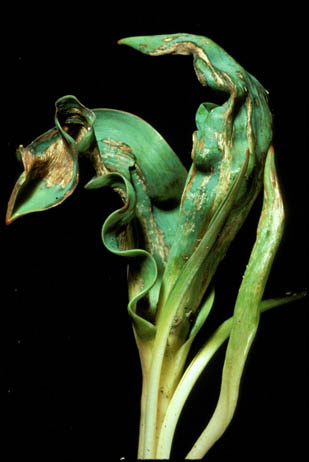Botrytis of Ornamentals | |
|---|---|
| May 28, 2008 | |
|
Botrytis blight is also referred to as “gray mold” and is one of the most common diseases of ornamentals. When high humidity is present, Botrytis blight can be a problem over a wide range of temperatures. When it comes to infection, the Botrytis pathogen is not picky, as it can affect a wide variety of hosts, especially dicots. Some flowers such as pointsettia, cyclamen, exacum, African daisy, and geranium have been reported to be more susceptible to Botryris at various stages of growth. This disease is best known in the green industry for its attacks on flowers or on foliage of nursery stock during overwintering. Botrytis attacks plant tissue that has been wet for longer than 4 hours. This pathogen commonly infects dead or wounded tissue but also affects nearby healthy foliage. Dead, infected flowers that fall on healthy leaves may initiate new infection. Fruits and flowers tend to be more inviting for infection, and nutrient-stressed leaves and pollen shed have been reported to stimulate infection. Not only does Botrytis affect a wide range of hosts, but it also can cause a wide range of symptoms, such as spots, leaf blight, petal blight, crown rot, stem cankers, cutting rot, and damping off. This disease can be confused with Fusarium diseases and bacterial soft rot. You will want to check plants for Botrytis once they have formed a dense canopy. Look for the characteristic powdery gray spores during humid conditions near affected areas on stems and leaves. Sometimes Botrytis lesions on leaves have a zonate pattern. The image shows Botrytis on some early-season tulip foliage.  It takes an integrated strategy to manage Botrytis—including environmental management, cultural practices, and fungicides. Always remove and destroy infected leaves, petals, or plants. If possible, try to avoid problem-prone cultivars. For more detailed control methods and fungicide recommendations, refer to the Illinois Commercial Landscape & Turfgrass Pest Management Handbook or the Home, Yard, & Garden Pest Guide. There are far too many products registered to list here. Relative humidity and leaf wetness are often monitored in a greenhouse environment, specifically to help manage Botrytis. Improving air circulation in a greenhouse setting often helps reduce infection. This may be accomplished by use of adequate spacing of plants, open-mesh benching and horizontal airflow systems. Plants should be watered in the morning so that leaves can dry by night. Growers may also avoid infection at night by providing ventilation and heat after sunset to reduce relative humidity below 85% and prevent condensation on plants. Some helpful resources for Botrytis blight include the University of Illinois Report on Plant Disease, no. 623, available at http://web.aces.uiuc.edu/vista/pdf_pubs/623.pdf; and this Web site by Cornell University, http://plantclinic.cornell.edu/factsheets/botrytis/botrytis_blight.htm. (Stephanie Porter, Plant Clinic Diagnostician) | |
| Author: | Nancy Pataky |
